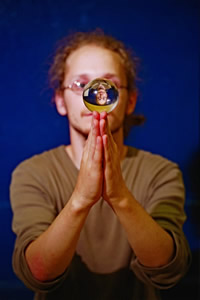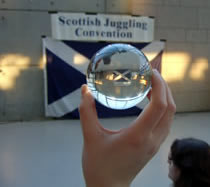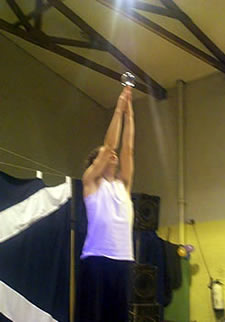 |
Contact Juggling is the ability to manipulate one or more balls while they stay in contact with your body the whole time. This usually involves the ball rolling from one part of the body to another in a smooth, flowing motion.
Any prop manipulation where the object stays in contact with the body is called contact juggling, so when you have been spinning a pen between your fingers while bored at work, you have been contact juggling! The Harlem Globetrotters basketball team have been entertaining people for decades with their combination of basketball skills and behind the neck rolls, arm rolls, spinning balls on fingers etc. When they manipulate the balls all over their body, this is a very entertaining example of what contact juggling is! |
Many peoples first glimpse of contact juggling will have been in a film called ‘Labyrinth’ which starred David Bowie. It looked like David Bowie was doing the tricks, but the hands actually belonged to Michael Moschen who is the man credited with starting the whole contact juggling movement. The latest Contact Juggling craze has started in 2010 with a ball called the Fushigi Gravity Ball, so a whole new wave of people are becoming entranced by this very visual art!
What do I need to do this?
Props: You will require a ball that is at least slightly larger than a normal juggling ball. A plastic stage ball is ideal for beginners. The ball should be hard and smooth (eg not squishy) as it is going to be rolling around parts of your body. You can use an acrylic ball, but it is far safer and easier to practice with a stage ball until you have mastered the basic moves. If you get addicted to contact juggling, you will soon be needing more than one ball!
First Trick – The Butterfly
 |
Butterfly: This is a move where the ball travels from your palm to the back of your hand via your middle finger while your hand performs a wave like motion.
|
This trick is one that can be returned to after many other tricks, so practice it well before moving on to the other tricks! This move is difficult, so be prepared to spend hours and even weeks or months to master this trick properly. The butterfly needs broken up into several parts. The first part lets you practice the Starting and Stopping positions of the final move.
- Pick up a ball in your favoured hand. Rest it on the palm, with your fingers pointing outwards (eg right handed people would point their hand out to the right).
- Manipulate the ball. Let it roll around your hand. This will get you used to the weight and feel of the ball. Try a little throw, and make sure that the catch is smooth and graceful.
- Change your hand so that it is facing palm downwards and your fingers are pointing in the opposite direction (your hand will be over the other side of your body now!) Place the ball on top of your hand in front of the first knuckle of the middle finger so that it rests between the ring and index fingers (the fingers on either side of the middle finger). This grip is known as the cradle and it is far easier to keep the ball still if your middle finger is slightly lower than the other two fingers!
- Try to throw and catch the ball a few times from this position (little throws!)The final move will be as smooth a transition as possible between these 2 moves you have just practiced. The next couple of exercises will help you work on getting the butterfly perfected! The throws and catches you are about to practice, will help you get used to manipulating the ball, but the final butterfly trick does not require the ball to leave your hand at all!
- Now we need to get the timing right. Try to throw the ball from one position to the other (from the palm to the cradle). Don’t worry about dropping the ball. This is bound to happen. Just keep trying!
- Now try balancing the ball in the palm of your hand, then roll it to the top of your middle finger, throw it in the air and then catch it in the cradle position.
- Now try the same move but in reverse! Start with your hand in the cradle position and roll it to the top of your middle finger, throw it upwards a little and catch it on the palm of your hand.
- Final step is to perform the butterfly without the ball being in the air at all! If you get stuck on this part, then go back and practice all of the previous moves over and over again.
- In one smooth motion, roll the ball from your palm to the cradle via the tip of your middle finger and then back again.
 |
Some tips for you:Many contact jugglers practice their moves standing beside a bed. This means that when the ball inevitably drops, it lands on a soft surface within easy reaching distance. Other contact jugglers prefer sitting on a gym mat or on the floor. |
This also means that the ball isn’t going to land on your toes from a great height!Practice with both hands. Once you have learned the butterfly and all other moves using one hand, learn it with the other.
More Tricks
| 2 Ball Palmspin | This is perhaps the simplest contact juggling move. It is simply moving 2 balls in your hand in one direction. Try clockwise in your right hand, then anti-clockwise, and try anti-clockwise in your left hand, then clockwise. To make it a bit more difficult, try rotating the balls as fast as you can, and then try each move without letting the balls touch each other. Don’t curl your fingers. A flat hand is a lot easier. |
| 3 Ball Palmspin | Just like the above trick, but with 3 balls instead of 2 rotating in your palm.
If you can hold 3 balls, then you can definitely spin them, even if your hand feels way too small! It just takes practice. Think of it as a sliding puzzle. You need to move one ball a little bit out to where there is some space on your hand, then move the next ball forward a little bit into the new gap that has just appeared. Keep repeating this process until it becomes smooth and you can speed it up. |
 |
What Next?
|
The next moves to learn with Contact Juggling are called things like Isolations, the Cage, Transitions. Type these words along with Contact Juggling trick into your favourite search engine and you should find out more about the next moves.

